
Digitaria is a genus of plants in the grass family native to tropical and warm temperate regions but can occur in tropical, subtropical, and cooler temperate regions as well. Common names include crabgrass, finger-grass, and fonio. They are slender monocotyledonous annual and perennial lawn, pasture, and forage plants; some are often considered lawn pests. Digitus is the Latin word for "finger", and they are distinguished by the long, finger-like inflorescences they produce.

Panicum (panicgrass) is a large genus of about 450 species of Poaceae grasses native throughout the tropical regions of the world, with a few species extending into the northern temperate zone. They are often large, annual or perennial grasses, growing to 1–3 m (3–10 ft) tall.
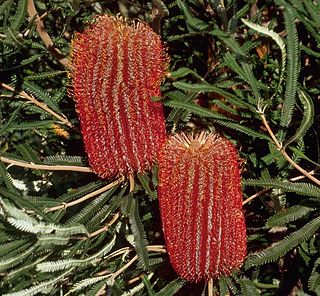
Banksia brownii, commonly known as feather-leaved banksia or Brown's banksia, is a species of shrub that grows in southwest Western Australia. A plant with fine feathery leaves and large red-brown flower spikes, it usually grows as an upright bush around two metres (6.6 ft) high, but can also occur as a small tree or a low spreading shrub. First collected in 1829 and published the following year, it is placed in Banksiasubgenus Banksia, section Oncostylis, series Spicigerae. There are two genetically distinct forms.
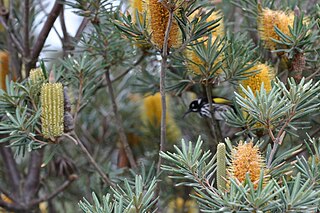
Banksia verticillata, commonly known as granite banksia or Albany banksia, is a species of shrub or (rarely) tree of the genus Banksia in the family Proteaceae. It is native to the southwest of Western Australia and can reach up to 3 m (10 ft) in height. It can grow taller to 5 m (16 ft) in sheltered areas, and much smaller in more exposed areas. This species has elliptic green leaves and large, bright golden yellow inflorescences or flower spikes, appearing in summer and autumn. The New Holland honeyeater is the most prominent pollinator, although several other species of honeyeater, as well as bees, visit the flower spikes.
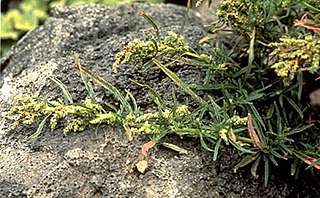
Amaranthus brownii was an annual herb in the family Amaranthaceae. The plant was found only on the small island of Nihoa in the Northwestern Hawaiian Islands, growing on rocky outcrops at altitudes of 120–215 m (394–705 ft). It was one of nine species of Amaranthus in the Hawaiian Islands, as well as the only endemic Hawaiian species of the genus. It is now considered extinct.
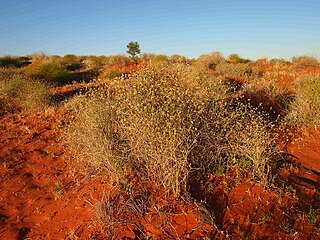
Zygochloa is a genus of desert plants in the grass family known only from Australia. The only known species is Zygochloa paradoxa, commonly known as sandhill canegrass. It occurs in extremely arid areas such as the Simpson Desert.
Banksia brunnea is a species of low, bushy shrub that is endemic to the south-west of Western Australia. It has dark green pinnatisect leaves, heads of up to seventy pink and brownish flowers and glabrous follicles in the fruiting head.

Leucophyta is a plant genus which is endemic to Australia. The genus was first formally described by botanist Robert Brown in 1818.

Verticordia brownii, commonly known as pink brownii or pink cauliflower is a flowering plant in the myrtle family, Myrtaceae, and is endemic to the south-west of Western Australia. It has small, neatly arranged, oval leaves and heads of pale pink to magenta or white flowers. It was one of the first verticordias to be collected, although it was not initially known by that name. The collection was made by Robert Brown on the Bass and Flinders circumnavigation of the Australian mainland on HMS Investigator.

Digitaria sanguinalis is a species of grass known by several common names, including hairy crabgrass, hairy finger-grass, large crabgrass, crab finger grass, purple crabgrass. It is one of the better-known species of the genus Digitaria, and one that is known nearly worldwide as a common weed. It is used as animal fodder, and the seeds are edible and have been used as a grain in Germany and especially Poland, where it is sometimes cultivated. This has earned it the name Polish millet.

Acacia brownii, commonly known as heath wattle, is an erect or spreading shrub which is endemic to eastern Australia.

Acacia argyrodendron, known colloquially as black gidyea or blackwood, is a species of Acacia native to Australia. Czech botanist Karel Domin described this species in 1926 and it still bears its original name. Domin reported collecting the type specimen from somewhere between Camooweal and Burketown in northwestern Queensland, though it is more likely to have been northeast of Aramac.

Buckinghamia celsissima, commonly known as the ivory curl tree, ivory curl flower or spotted silky oak, is a species of tree in the family Proteaceae. It is endemic to the tropical rainforests of northeastern Queensland, Australia.

Digitaria insularis is a species of grass commonly known as sourgrass. It is native to Central and South America and the southern parts of the United States and has been introduced into other parts of the world. It was first described by the German botanist Friedrich Karl Georg Fedde in 1904.

Calytrix brownii, commonly known as the white turkeybush, is a species of plant in the myrtle family Myrtaceae and is endemic to northern Australia. It is an erect or prostrate shrub with linear to narrowly elliptic leaves and white to creamish, star-shaped flowers with about 18 to 25 white stamens in a single row.
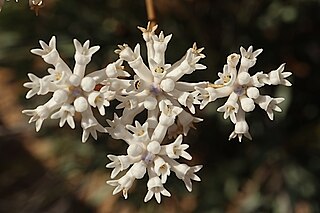
Conospermum brownii, commonly known as blue-eyed smokebush, is a species of flowering plant in the family Proteaceae and is endemic to the south-west of Western Australia. It is a more or less open shrub with glaucous, lance-shaped leaves with the narrower end towards the base, and spike-like corymbs of white to cream-coloured flowers.

Carex fascicularis, commonly known as tassel sedge, is a species of sedge of the family Cyperaceae that is native to Australia, New Zealand and New Guinea.

Bossiaea brownii is a species of flowering plant in the family Fabaceae and is endemic to eastern Queensland. It is an erect shrub with egg-shaped leaves and yellow flowers with red markings.

Eragrostis brownii is a widespread species of grass known as Browns lovegrass. Found in Australia and New Zealand, it may be seen growing in woodland or pasture. The grass may grow up to .6 m tall. The specific epithet brownii is named in honour of the Scottish botanist Robert Brown.
Digitaria porrecta, commonly known as finger panic grass, is a species of perennial grass (Poaceae).


















